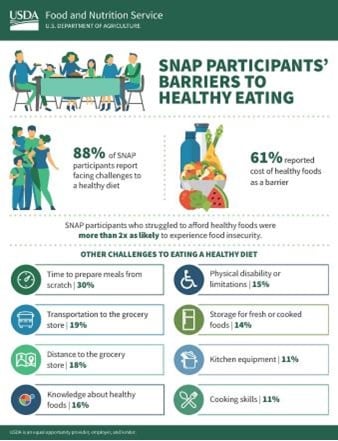According to a survey conducted by the US Department of Agriculture published yesterday, 88% of SNAP recipients routinely face hurdles to a healthy diet with cost being the most frequently cited challenge by 61% of participants, followed by lack of time to prepare meals from scratch (30%), need for transportation or distance to the grocery store (19% and 18% respectively) and lack of knowledge about healthy foods (16%).
The survey of 4,522 SNAP households and more than 100 in-depth interviews was conducted by the USDA and Institute of Medicine and the National Research Council as a first step to determine “objectively” if current SNAP benefits are adequate for maintaining a healthy diet, and findings suggest “we’re not there yet,” USDA deputy undersecretary for food, nutrition and consumer services Stacy Dean said in a statement.
With this in mind and at the behest of Congress in the 2018 Farm Bill, USDA says it is actively re-evaluating how SNAP benefits are determined – including the Thrifty Food Plan, on which benefit amounts are based.
The TFP was introduced first in 1975 and since that time has only been adjusted for inflation, according to USDA, which notes that since that time, “our understanding of nutrition has evolved significantly, and there have been major changes to the food supply, consumption patterns and the circumstances of SNAP participants, resulting in an out-of-date food plan.”
By reevaluating the TFP, USDA says that it will help ensure SNAP families can afford a “realistic, healthy diet on a budget.”
While the agency’s review of the TFP and SNAP benefits was underway long before the coronavirus outbreak, the pandemic elevated and accelerated the need for the re-evaluation as the number of Americans reliant on SNAP swelled 16% in April 2020 from the prior month to reach 42 million people.

Education, low-prep options needed
Recognizing that increasing the SNAP allotment may not be viable, the report urges stakeholders to consider alternative policies and programs, including expanding the reach of SNAP-Ed, which teaches participants how to follow a healthy diet with limited cooking equipment or skills.
This also is an area where industry players may be able to help SNAP beneficiaries – and in doing so potentially capture a larger share of the roughly $55b that IRI Worldwide estimates SNAP beneficiaries spend on food and beverage annually.
For example, by creating nutritious options that require little or no prep or special tools, companies could appeal to the 11% of SNAP recipients who noted in the survey that a lack of kitchen equipment was a barrier to following a healthy diet and the 11% who listed insufficient cooking skills as a reason.
Likewise, creating educational programs or digital campaigns that focus on helping consumers hone their cooking skills or better understand what constitutes a healthy diet could draw to their products some of the 16% of recipients who listed lack of knowledge about healthy food as a barrier.
Lower prices of key items could increase loyalty, foot traffic
Reducing the price point or adjusting the pack size of healthy items that SNAP beneficiaries struggle to afford also could help manufacturers and retailers connect with SNAP beneficiaries.
According to the study, price was the largest barrier to a healthy diet for SNAP participants, with 43% noting they found it difficult or very difficult to afford fresh fruits compared to 38% who noted the same of fresh vegetables, 29% of whole grain products and 50% of lean meat.
Some retailers and DTC companies are lowering the cost of produce for SNAP beneficiaries and food insecure consumers with prescriptions for free produce – a move that allows them to bill participating insurers and frees up beneficiaries’ funds to spend elsewhere in the store or on their website.




